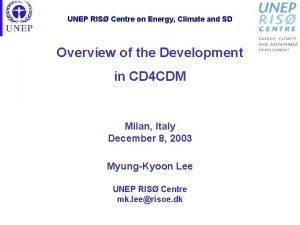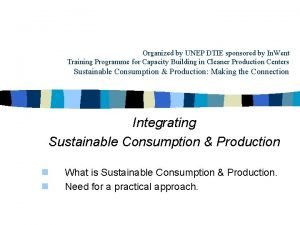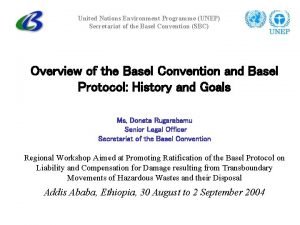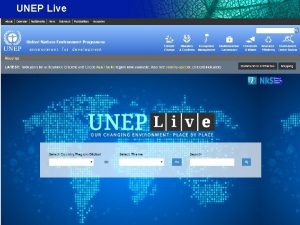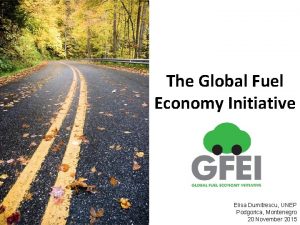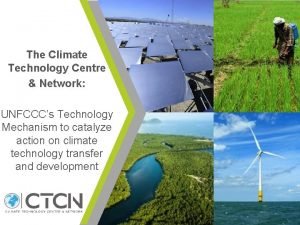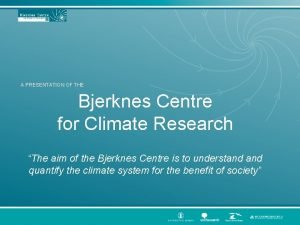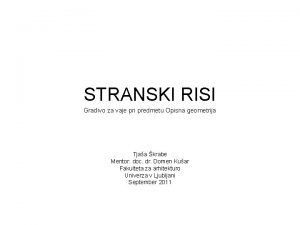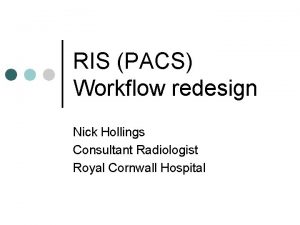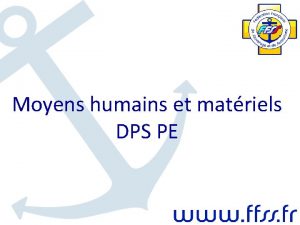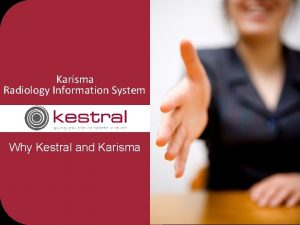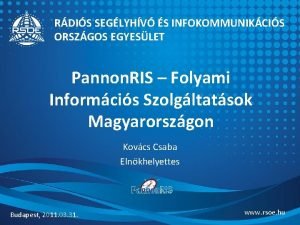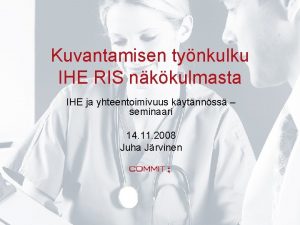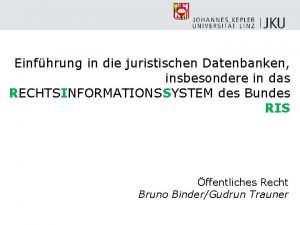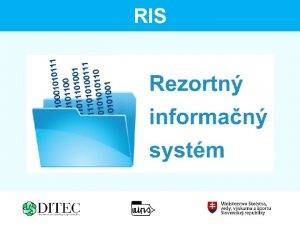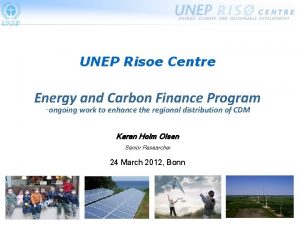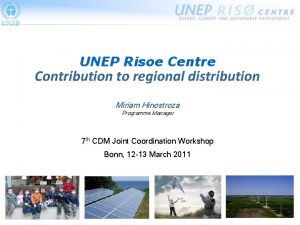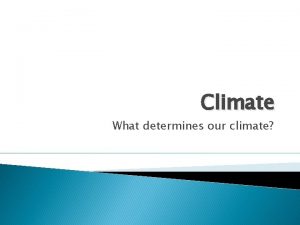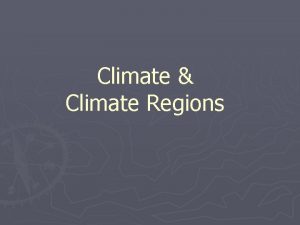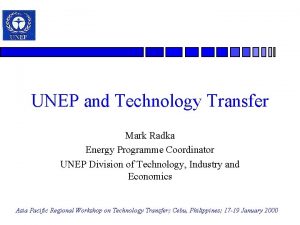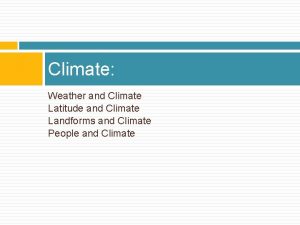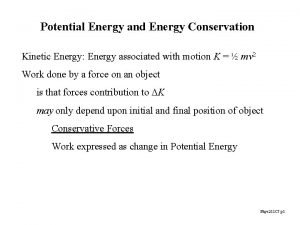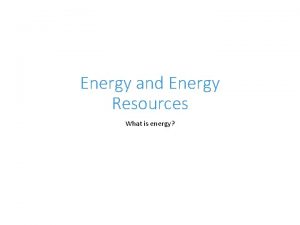UNEP RIS Centre on Energy Climate and SD






















- Slides: 22

UNEP RISØ Centre on Energy, Climate and SD Overview of the Development in CD 4 CDM Milan, Italy December 8, 2003 Myung-Kyoon Lee UNEP RISØ Centre mk. lee@risoe. dk

UNEP RISØ Centre on Energy, Climate and SD Overview of CD 4 CDM – Donor: the Netherlands Ministry of Foreign Affairs – Implementing Agency: UNEP RISØ Centre on Energy, Climte & Sustainable Development – Phase I: Feb. 2002 – 2 nd quarter of 2003, preparation of national work plans – Phase II: 3 rd quarter of 2003 – end of 2005, implementation of national work plans

UNEP RISØ Centre on Energy, Climate and SD Main goals – generating a broad understanding of the CDM in the developing countries – developing institutional capability and human capacity of the developing countries to fully participate as equal partners with developed countries in the formulation and implementation of the Clean Development Mechanism (CDM).

UNEP RISØ Centre on Energy, Climate and SD Participating Countries – three countries each from four regions – Asia: Cambodia, the Philippines, Viet Nam – Latin America: Bolivia, Ecuador, Guatemala – Middle East & North Africa: Egypt, Jordan, Morocco – Sub-Saharan Africa: Côte d’Ivoire, Mozambique, Uganda

UNEP RISØ Centre on Energy, Climate and SD Main Tasks – sensitizing government supports for the CDM – developing capacity of policy makers – establishing institutional framework for the CDM projects – strengthening capabilities of the public and private sectors – creating a pipeline of the CDM projects

UNEP RISØ Centre on Energy, Climate and SD Implementation Strategy URC RCs CTs studies, surveys, training courses, workshops, seminars, consultations, information sharing and dissemination

UNEP RISØ Centre on Energy, Climate and SD Main Activities in Phase I • Completing national work plans – National teams were set up and working on national work plans. – All 12 countries finished work plans and getting into phase II. • “Introduction to the CDM” – Translation into local languages: French, Arabic, Spanish, Vietnamese, Cambodian, Portuguese, Chinese, Japanese, Korean

UNEP RISØ Centre on Energy, Climate and SD Main Activities in Phase II – Establishing institutional and legal framework: first half of 2004 – Training DNA staff and the private sector participants (project developers, financial sector, academia and research institutions, NGOs) – Regional and national workshops: training, reviewing, planning, implementing, sharing – Identifying potential projects: 2004 - 2005 – Creating a pipeline

UNEP RISØ Centre on Energy, Climate and SD Current Progress Latin America ME & NA completed KP ratification Cambodia, Philippines, Viet Nam Bolivia, Ecuador, Guatemala Morocco, R Jordan, A Egypt, S Uganda, A DNA Viet Nam, Cambodia Bolivia, Ecuador Morocco, Egypt none Sep. 2003 Dec. 2003 Sep. 2003 Oct. 2003 Asia Phase I Nov. 2003 Regional workshops Mar. 2004 SSA

UNEP RISØ Centre on Energy, Climate and SD Information Sharing and Collaboration – Advisory body invited: NL, UNFCCC, WB, UNF, UNIDO, UNDP, ADB, WBCSD – New members to AB: IGES, e 7 – Information sharing with private sector

UNEP RISØ Centre on Energy, Climate and SD Development of Background Materials – Introduction to the CDM: 2002 – CDM Information and Guidebook: Dec. 2003 – Institutional strategy to promote the CDM in Peru: Feb. 2004 – CDM legal issues Guidebook: May 2004 – Institutional issues in CDM implementation: May 2004 – CDM and Sustainable Development: Feb. 2004 – Guidebook on developing baselines for CDM projects: June 2004 – Bundling of small-scale CDM projects: May 2004 – Case studies on the contribution of the CDM to SD in selected LA countries (Bolivia, Ecuador, Colombia, Uruguay): May 2004

UNEP RISØ Centre on Energy, Climate and SD Introduction to the CDM – A popular guidebook to introduce the CDM to the general public. – It summarizes the essence of the CDM including : a historical overview : a brief overview of the CDM project cycle : the national values and benefits of participation in the CDM : a national strategy to promote the CDM. – It illustrates several examples of possible CDM projects based on previous AIJ, ALGAS, and PCF projects – Published and distributed in 2002 and

UNEP RISØ Centre on Energy, Climate and SD CDM Information and Guidebook (1) – Focusing on the project cycle and PDD as well as touching various aspects of the CDM – Ch. 2 overviews the CDM drawn upon ”Introduction to the CDM” by URC summarizing brief project cycle and the national values and benefits of participation in the CDM. – Ch. 3 visits the issue of SD from the perspective of a CDM project. This chapter presents an example of SD indicators and major steps of an SD evaluation of CDM projects. – Ch. 4 explains each step of the project cycle with informative tables and numbers.

UNEP RISØ Centre on Energy, Climate and SD CDM Information and Guidebook (2) – Chapter 6 provides an overview on impact of CERs on project viability, sources of funds and risk management. – The last chapter, Chapter 7, reviews recent CER market transactions and price trends. – Appendices present frequently asked questions and answers, a short overview of existing guidelines, and a possible future list of eligible CDM projects categories.

UNEP RISØ Centre on Energy, Climate and SD Institutional strategy to promote the CDM in Peru – It shows the way in which Peru has designed an institutional strategy to promote the projects eligible for the CDM. – The description of this process might be useful to other countries interested in establishing DNA to participate in the CDM. – Peru’s activities in the CC negotiation and Peruvian legal and instutional context for the CDM – In Operationalization of DNA, it describes problems encountered and how Peru has solved them including composition and structure of DNA and how to finance it.

UNEP RISØ Centre on Energy, Climate and SD CDM and Sustainable Development – Providing an overview of how CDM projects can be evaluated in the context of SD. – Following a general introduction on the linkage of CDM to SD, presented is the national development context of evaluating SD impacts of CDM projects. – Introduction of SD in relation to CDM projects – Short overview of what will be involved in an SD evaluation of CDM projects – How to select and evaluate indicators – How to use the SD evaluation in decision making – Case studies illustrating different indicators and approaches – Short overview of how other CDM capacity building projects or guidelines address SD aspects of CDM

UNEP RISØ Centre on Energy, Climate and SD Case studies on the contribution of the CDM to SD in selected LA countries – Two CD 4 CDM project countries (Bolivia and Ecuador) and two other countries in LA (Colombia and Uruguay) – Each country will undertake a few specific case studies to describe the way the country is to assess the contribution of the CDM projects to national SD: one EE, one RE + one sink project, but different project types from different countries – Case studies include how the criteria and SD indicators are applied in existing CDM project proposals

UNEP RISØ Centre on Energy, Climate and SD CDM Legal Issues Guidebook – The main objective is to provide developing country stakeholders with advice on legal and regulatory pitfalls host country CDM stakeholders need to watch for during the various stages of CDM project development. – The Guidebook is intended to give as much examples and hints as possible on what could go legally wrong in a CDM project and the type of risks that may face both the CDM investor and the host country, while presenting logical and simple legal, contractual, and/or regulatory solutions. – Want to show developing countries can take care of their own interests and at the same time develop efficient CDM projects through alternative

UNEP RISØ Centre on Energy, Climate and SD Guidebook on developing baselines for CDM Projects (1) – Baseline is a key component for a CDM project to be validated and to generate CERs. – Baseline guidebook aims to provide project developers and other stakeholders of the CDM with a clear definition of baseline and calculation methodologies for different types of CDM projects.

UNEP RISØ Centre on Energy, Climate and SD Guidebook on developing baselines for CDM Projects (2) – – – key components of developing baseline methodology the steps to use baseline methodologies for small scale projects the step wise approach to the selection of project specific baselines application of baseline methodology for selected projects the issues in developing baseline for A&R projects Annex will present some of the econometric and optimization models, such as LEAP, MARKAL, ENPEP used for analysis of baseline emissions. Presented will be the model structure, data requirements, underlying assumptions and limitations of these models.

UNEP RISØ Centre on Energy, Climate and SD Financial Issues in the CDM – The main objective of the guideline is to present the implications of CERs as an additional CDM project benefit and to present approaches in dealing with several financial issues associated with CER generation. – Chapter 1 will analyze the impact of CERs on project viability and will discuss issues related to carbon revenues, transaction costs, etc. – Chapter 2 will analyze CER implications on project finance. This will review the emerging arrangement in CER procurement and the new sources of project funds. This part will also present how the CERs could improve the debt carrying capacity of the project. – Chapter 3 will present new risks associated with CER generation and the approaches in mitigating these risks. – Chapter 4 will present the emerging CER market development and the implications of the proposed linkage with the EU-ETS,

UNEP RISØ Centre on Energy, Climate and SD Bundling of Small Scale CDM Projects – Criteria: small-scale CDM projects – Rationale - high transaction costs - a large number of EE and RE projects meeting SD and host priority criteria are small-scale – Advantages - simplified baseline and monitoring methodology can be used - small-scale project developers can also benefit from the CDM – Issues to be covered: approaches and procedures - how to bundle and what type of projects? - how to address issue of differing baselines and monitoring requirements? - who should bundle? - what kind of arrangements are possible between stakeholders?
 Unep
Unep Unep
Unep Unep secretariat
Unep secretariat Unep
Unep Unep live
Unep live монтенегро
монтенегро Unep mandate
Unep mandate Climate technology centre and network
Climate technology centre and network Climate change 2014 mitigation of climate change
Climate change 2014 mitigation of climate change Problems on centroid in engineering mechanics
Problems on centroid in engineering mechanics Difference between centre of gravity and centroid
Difference between centre of gravity and centroid Bjerknes centre for climate research
Bjerknes centre for climate research Energy energy transfer and general energy analysis
Energy energy transfer and general energy analysis Energy energy transfer and general energy analysis
Energy energy transfer and general energy analysis Stranski ris
Stranski ris Ris pacs workflow diagram
Ris pacs workflow diagram Calcul ris dps
Calcul ris dps Karisma radiology
Karisma radiology Pannon led kft
Pannon led kft Galleri ris
Galleri ris Connectathon
Connectathon Ris gesamtabfrage
Ris gesamtabfrage Et jamais je ne pleure et jamais je ne ris
Et jamais je ne pleure et jamais je ne ris
